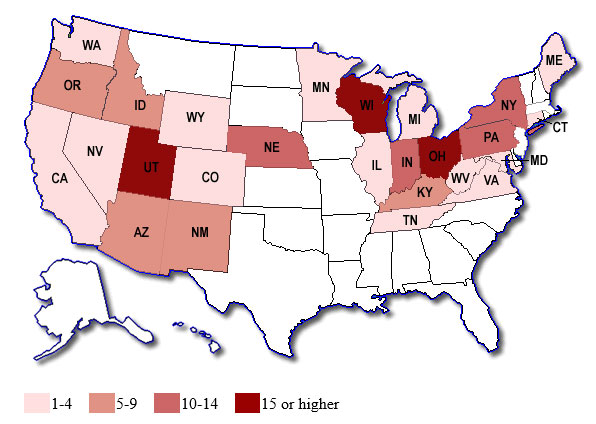2006 E. coli Outbreak Linked to Fresh Spinach
NOTICE: This outbreak is over. The information on this page has been archived for historical purposes only and will not be updated.
Posted October 6, 2006
Outbreak Summary
As of 1 PM (ET) October 6, 2006, Friday, 199 persons infected with the outbreak strain of E. coli O157:H7 have been reported to CDC from 26 states.
Among the ill persons, 102 (51%) were hospitalized and 31 (16%) developed a type of kidney failure called hemolytic-uremic syndrome (HUS). One hundred forty-one (71%) were female and 22 (11%) were children under 5 years old. The proportion of persons who developed HUS was 29% in children (<18 years old), 8% in persons 18 to 59 years old, and 14% in persons 60 years old or older. Among ill persons who provided the date when their illnesses began, 80% became ill between August 19 and September 5. The peak time when illnesses began was August 30 to September 1- 31% of persons with the outbreak strain became ill on one of those 3 days.
Three deaths in confirmed cases have been associated with the outbreak. One was in an elderly woman from Wisconsin. Yesterday, Idaho confirmed that stool samples from a 2-year-old child with HUS who died on September 20 contained E. coli O157 with a “DNA fingerprint” pattern that matches the outbreak strain. Today, Nebraska reported the death of an elderly woman with an illness compatible with E. coli O157 infection who consumed raw spinach; E. coli O157 with the outbreak strain “DNA fingerprint” was detected in the remaining spinach.
Maryland is investigating a suspect case in an elderly woman who died on September 13 and had recently consumed fresh spinach. E. coli O157 was cultured from her stool, but “DNA fingerprinting” has not been possible.
E. coli O157 was isolated from 13 packages of spinach supplied by patients living in 10 states. Eleven of the packages had lot codes consistent with a single manufacturing facility on a particular day. Two packages did not have lot codes available but had the same brand name as the other packages. The “DNA fingerprints” of all 13 of these E. coli match that of the outbreak strain.
Final Case Count Map
Persons infected with the outbreak strain of E. coli O157:H7, by state of residence, as of October 6, 2006 (n=199)

Advice to Consumers
The following is advice for consumers about this outbreak:
- Consumers should not eat, retailers should not sell, and restaurants should not serve spinach implicated in the E. coli O157:H7 outbreak. Products implicated in the outbreak include fresh spinach and spinach-containing products from brands processed by Natural Selection Foods.
- If consumers cannot tell if a brand of fresh spinach was implicated in the outbreak and the package has a “use-by date” of October 1, 2006 or earlier, they should not eat it.
- E. coli O157:H7 in spinach can be killed by cooking at 160° Fahrenheit for 15 seconds. (Water boils at 212° Fahrenheit.) If spinach is cooked in a frying pan, and all parts do not reach 160° Fahrenheit, all bacteria may not be killed. If consumers choose to cook the spinach, they should not allow the raw spinach to contaminate other foods and food contact surfaces, and they should wash hands, utensils, and surfaces with hot, soapy water before and after handling the spinach.